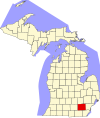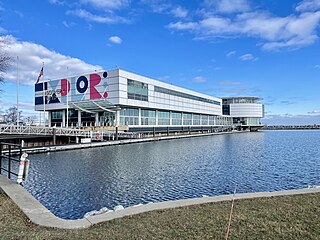
Discovery World is a science and technology museum in Milwaukee, Wisconsin.
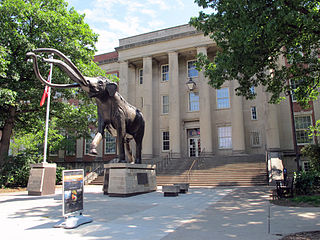
The University of Nebraska State Museum, also known as Morrill Hall, founded in 1871, is a natural history museum featuring Nebraska biodiversity, paleontology, and cultural diversity, located on the University of Nebraska–Lincoln City Campus near the corner of 14th and Vine Streets in Lincoln, Nebraska, United States. The museum houses Mueller Planetarium, a hands-on science discovery center, and the Elephant Hall, where visitors can see the world's largest articulated fossil mammoth among the collection of fossil elephants. Also featured are interactive paleontology exhibits, a dinosaur gallery, ancient life and evolution exhibits, wildlife dioramas, gems and minerals, American Indian and African exhibits, and a temporary exhibit gallery featuring rotating displays on diverse topics including photography, quilts and fine arts.

The Museum of Science (MoS) is a nature and science museum and indoor zoological establishment located in Science Park, a plot of land in Boston and Cambridge, Massachusetts, spanning the Charles River. Along with over 700 interactive exhibits, the museum features a number of live and interactive presentations throughout the building each day, along with scheduled film showings at the Charles Hayden Planetarium and the Mugar Omni Theater. Additionally, the Museum of Science is an accredited member of the Association of Zoos and Aquariums (AZA), being home to over 100 animals, many of which the museum gained after they were surrendered, confiscated, rescued or rehabilitated.

DTE Energy is a Detroit-based diversified energy company involved in the development and management of energy-related businesses and services in the United States and Canada. Its operating units include an electric utility serving 2.2 million customers and a natural gas utility serving 1.3 million customers in Michigan.

The Great Lakes Science Center is a museum and educational facility in downtown Cleveland, Ohio, United States. Many of the exhibits document the features of the natural environment in the Great Lakes region of the United States. The facility includes signature (permanent) and traveling exhibits, meeting space, a cafe, and an IMAX Dome theater.

Boston Children's Museum is a children's museum in Boston, Massachusetts, dedicated to the education of children. Located on Children's Wharf along the Fort Point Channel, Boston Children's Museum is the second oldest children's museum in the United States. It contains many activities meant to both amuse and educate young children.

The Houston Museum of Natural Science is a natural history museum located on the northern border of Hermann Park in Houston, Texas, United States. The museum was established in 1909 by the Houston Museum and Scientific Society, an organization whose goals were to provide a free institution for the people of Houston focusing on education and science. The museum complex consists of a central facility with four floors of natural science halls and exhibits, the Burke Baker Planetarium, the Cockrell Butterfly Center, and the Wortham Giant Screen Theatre. In 2022, the museum received 1,520,000 visitors, making it seventh on the List of most-visited museums in the United States, and was the third most-visited U.S. science museum. Much of the museum's popularity is attributed to its large number of special or guest exhibits.
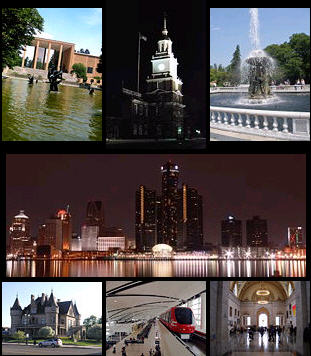
Tourism in metropolitan Detroit, Michigan is a significant factor for the region's culture and for its economy, comprising nine percent of the area's two million jobs. About 19 million people visit Metro Detroit spending an estimated 6 billion in 2019. In 2009, this number was about 15.9 million people, spending an estimated $4.8 billion. Detroit is one of the largest American cities and metropolitan regions to offer casino resort hotels. Leading multi-day events throughout Metro Detroit draw crowds of hundreds of thousands to over three million people. More than fifteen million people cross the highly traveled nexus of the Ambassador Bridge and the Detroit-Windsor Tunnel annually. Detroit is at the center of an emerging Great Lakes Megalopolis. An estimated 46 million people live within a 300-mile (480 km) radius of Metro Detroit.

The Michigan Science Center(MiSci) is a Smithsonian-affiliate science museum in Detroit, Michigan. The mission of the Michigan Science Center is to inspire curious minds of all ages to discover, explore and appreciate science, technology, engineering and math (STEM) in a creative, dynamic learning environment. As a 501(c)(3) nonprofit organization, MiSci relies on the generous support of donors, sponsors, community partners and members.

The National Museum of Nuclear Science & History is a national repository of nuclear science information chartered by the 102nd United States Congress under Public Law 102-190, and located in unincorporated Bernalillo County, New Mexico, with an Albuquerque postal address. It is adjacent to both the Albuquerque city limits and Kirtland Air Force Base.

A green museum is a museum that incorporates concepts of sustainability into its operations, programming, and facility. Many green museums use their collections to produce exhibitions, events, classes, and other programming to educate the public about the natural environment. Many, but not all, green museums reside in a building featuring sustainable architecture and technology. Green museums interpret their own sustainable practices and green design to present a model of behavior.

Discovery Station, is a hands-on, family-friendly museum in downtown Hagerstown, Maryland, United States that opened to the public in 2005. The museum's focus is to create an environment that stimulates curiosity for discovery, exploration, and further investigation through exhibits and programs that focus on Science, Technology, Engineering, Art, and Math (STEAM) principles. The museum is a member of the Association of Science and Technology Centers (ASTC), the American Alliance of Museums (AAM), and the NASA Museum Alliance.
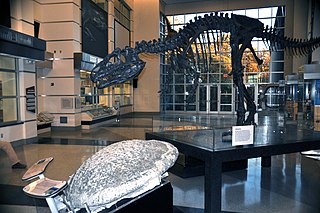
The Virginia Museum of Natural History is the state's natural history museum located in Martinsville, Virginia founded in 1984. The museum has several different award-winning publications, is affiliated with the Smithsonian Institution, and has more than 22 million items. This includes the first intact stromatolite head ever found in Virginia, which is one of the largest complete 'heads' in the world, at over 5 feet in diameter and weighing over 2 tons.

The Exploratorium is a museum of science, technology, and arts in San Francisco, California. Founded by physicist and educator Frank Oppenheimer in 1969, the museum was originally located in the Palace of Fine Arts and was relocated in 2013 to Piers 15 and 17 on San Francisco's waterfront.

The Gerald R. Ford Presidential Museum is the presidential museum and burial place of Gerald Ford, the 38th president of the United States (1974–1977), and his wife Betty Ford. It is located near the Pew Campus of Grand Valley State University in Grand Rapids, Michigan. Ford's presidential museum is the only such facility under the auspices of the National Archives and Records Administration to be separate from the presidential library, which is located approximately 130 miles (210 km) to the east in Ann Arbor. Despite the separation, the library and museum are a single institution with one director.

The Ecology Center is a membership-based nonprofit environmental organization based in Ann Arbor, Michigan. It works at the local, state and national levels on environmental justice, health, waste, and community issues. It was formed after the first Earth Day in 1970 by community activists in Ann Arbor. Since its founding, it has run demonstrations and campaigns to promote recycling, health care, education, and awareness about healthy foods and products.

The Da Vinci Science Center (DSC) is a science museum and nonprofit organization in Allentown, Pennsylvania. It was founded in 1992. The center has been a leader in "bringing science to life and lives to science", according to its mission statement. The center's slogan is Open for ExSCIting Possibilities.
Physics outreach encompasses facets of science outreach and physics education, and a variety of activities by schools, research institutes, universities, clubs and institutions such as science museums aimed at broadening the audience for and awareness and understanding of physics. While the general public may sometimes be the focus of such activities, physics outreach often centers on developing and providing resources and making presentations to students, educators in other disciplines, and in some cases researchers within different areas of physics.

The Michigan Firehouse Museum and Education Center is a fire museum dedicated to the history of firefighting in the U.S. state of Michigan. It is located at 110 West Cross Street in Ypsilanti, Michigan.
The Upper Peninsula Children's Museum (UPCM) is a nonprofit children's museum in Marquette, Michigan, in the United States. The interactive museum features numerous exhibits that were designed by children to combine play with art, health, science, communication, and the local Upper Peninsula environment.





















